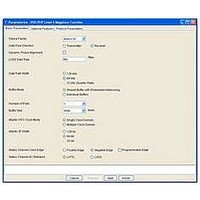IP-POSPHY4 Altera, IP-POSPHY4 Datasheet - Page 57

IP-POSPHY4
Manufacturer Part Number
IP-POSPHY4
Description
IP CORE - POS-PHY Level 4 SPI 4.2 Interface
Manufacturer
Altera
Type
MegaCorer
Datasheet
1.IP-POSPHY4.pdf
(144 pages)
Specifications of IP-POSPHY4
Software Application
IP CORE, Interface And Protocols, COMMUNICATION
Supported Families
Arria GX, Cyclone, HardCopy, Stratix
Core Architecture
FPGA
Core Sub-architecture
Arria, Cyclone, Stratix
Rohs Compliant
NA
Function
POS-PHY Level 4 Interface, Link-Layer/PHY Layer
License
Initial License
Lead Free Status / RoHS Status
na
Lead Free Status / RoHS Status
na
- Current page: 57 of 144
- Download datasheet (3Mb)
Chapter 4: Functional Description—Receiver
Error Flagging and Handling
December 2010 Altera Corporation
DIP-4 Marking
1
1
After the optional channel aligner, the training pattern is treated as IDLEs and
discarded. The training pattern has no internal function because the data entering the
MegaCore function is already byte aligned.
A status flag, stat_rd_tp_flag, is also provided. This flag pulses high for one clock
cycle at the end of the training pattern to indicate that a correct training pattern has
been detected. This flag pulses once for every occurrence of 10 (repeated) training
control words followed by 10 (repeated) training data words. This flag does not
indicate that the data path has been deskewed.
The receiver MegaCore function supports three different ways of handling DIP-4
errors. In the first mode, the none mode, the err_rd_dip4 signal is asserted but no
packets are marked as errored. You should use a higher level CRC or FCS to detect
packets with errors. In the second mode, the optimistic mode, the MegaCore function
only marks packets that have a high probability of having errors. In the third mode,
the pessimistic mode, the MegaCore function assumes the worst case and marks any
packet that may have errors. In all modes, if the MegaCore function detects a DIP-4
error, it asserts the err_rd_dip4 signal.
The optimistic and pessimistic modes are discussed further in these sub-sections,
where an open packet is a packet for which a SOP but not an EOP has been received
when the error was detected.
Optimistic Mode
This mode attempts to error individual bursts as opposed to entire packets. Any data
burst incoming on the SPI-4.2 interface is marked with an Atlantic error if its starting
payload control word contains a DIP-4 error, or its terminating control word contains
a DIP-4 error.
If the starting payload control word contains a DIP-4 error, the aN_arxerr signal is
asserted for as long as the burst is present on the Atlantic interface. If the terminating
control word contains a DIP-4 error, the aN_arxerr signal is asserted on the last
Atlantic data cycle of the burst.
The MegaCore function does not keep track of open packets containing errors that
have not been terminated with an EOP. The Atlantic error signal is not held until EOP
and it is up to the user logic to ensure that errors are carried across continued packets
if required.
In cases where the terminating control word contains an EOP, the associated
aN_arxmty value is not rounded down to the nearest even value.
Pessimistic Mode
In the event of a DIP-4 error, all open packets are marked. All subsequent data for
each port is marked until a new SOP for that port is received.
Because of the logic required to track open packets per ports, this feature uses a large
amount of logic for systems with many ports.
POS-PHY Level 4 MegaCore Function User Guide
4–17
Related parts for IP-POSPHY4
Image
Part Number
Description
Manufacturer
Datasheet
Request
R

Part Number:
Description:
IP CORE Renewal Of IP-POSPHY4
Manufacturer:
Altera
Datasheet:

Part Number:
Description:
IP Thermal Transfer Printer With Peel/Present Option
Manufacturer:
BRADY

Part Number:
Description:
CYCLONE II STARTER KIT EP2C20N
Manufacturer:
Altera
Datasheet:

Part Number:
Description:
CPLD, EP610 Family, ECMOS Process, 300 Gates, 16 Macro Cells, 16 Reg., 16 User I/Os, 5V Supply, 35 Speed Grade, 24DIP
Manufacturer:
Altera Corporation
Datasheet:

Part Number:
Description:
CPLD, EP610 Family, ECMOS Process, 300 Gates, 16 Macro Cells, 16 Reg., 16 User I/Os, 5V Supply, 15 Speed Grade, 24DIP
Manufacturer:
Altera Corporation
Datasheet:

Part Number:
Description:
Manufacturer:
Altera Corporation
Datasheet:

Part Number:
Description:
CPLD, EP610 Family, ECMOS Process, 300 Gates, 16 Macro Cells, 16 Reg., 16 User I/Os, 5V Supply, 30 Speed Grade, 24DIP
Manufacturer:
Altera Corporation
Datasheet:

Part Number:
Description:
High-performance, low-power erasable programmable logic devices with 8 macrocells, 10ns
Manufacturer:
Altera Corporation
Datasheet:

Part Number:
Description:
High-performance, low-power erasable programmable logic devices with 8 macrocells, 7ns
Manufacturer:
Altera Corporation
Datasheet:

Part Number:
Description:
Classic EPLD
Manufacturer:
Altera Corporation
Datasheet:

Part Number:
Description:
High-performance, low-power erasable programmable logic devices with 8 macrocells, 10ns
Manufacturer:
Altera Corporation
Datasheet:

Part Number:
Description:
Manufacturer:
Altera Corporation
Datasheet:

Part Number:
Description:
Manufacturer:
Altera Corporation
Datasheet:











